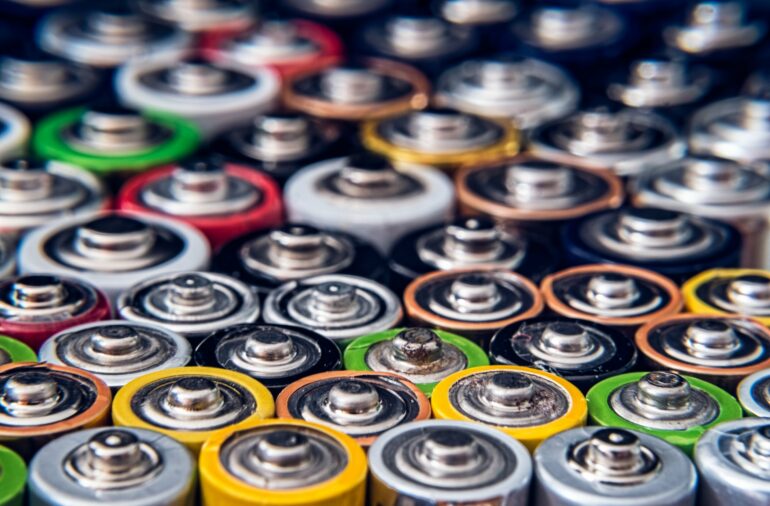Automated sprinklers, lighting, and security systems have been commonplace in homes and offices for several decades. In recent years, however, they have become increasingly efficient at anticipating user needs and optimizing their performance due to their ability to communicate information over wireless networks. This emerging phenomenon is known as the Internet of Things (IoT), and it describes how interconnected devices parse data to one another without human intervention to enhance their convenience.
And as the IoT and robotics industries continue to grow and evolve, there is an increasing demand for smaller, more energy-dense, batteries to power these interconnected devices. This has led to the development of microbatteries, miniature batteries that can provide power to small IoT devices like sensors, wearable smart devices, drones, and tiny robots.
Penn Today met with James Pikul, associate professor in the Department of Mechanical Engineering and Applied Mechanics at the School of Engineering and Applied Science, to discuss the challenges engineers face in manufacturing the next generation of microbatteries and to learn how designing new configurations can allow for both smaller dimensions and greater energy storage.
Problems with downsizing
Pikul’s lab develops and has been working to improve microbatteries. A major hurdle in designing batteries to power tiny devices is that batteries suffer from deficits in energy storage and performance when their dimensions are reduced, explains Pikul. “Energy scales with volume, which is length multiplied by length multiplied by length, so length cubed,” he says.
“If you want to make a battery 10-times smaller in every dimension, it now has 10 times 10 times 10 (a thousand times) less energy. That’s one of the major challenges.”
The packaging materials used to house batteries also pose a major impediment to scaling.
“The electrochemical reactions that allow batteries to generate power are sensitive to contamination, so they need to be encased in a hermetically sealed packaging material,” Pikul says.
He explains that packaging materials need to have a certain thickness to prevent leakages and contamination, but as batteries become smaller, the thickness of the materials can add unwanted volume and mass. Pikul likens this constraint to boxing up a laptop versus a phone with the same packaging materials.
“In terms of total volume, the ratio of the cardboard box to the laptop is much less than the ratio of the cardboard box to the phone if the cardboard has the same thickness,” he says. “So, making packaging that’s really small, using battery materials that have a high amount of energy stored per unit of volume (energy density), and coming up with new architectures that optimally arrange these materials in 3D space are how we’re trying to overcome these problems.”
Unpacking the energy storage problem
In 2019, Pikul and his collaborators began addressing some of the packaging constraints as part of a project funded by DARPA’s SHort-Range Independent Microrobotic Platforms (SHRIMP) initiative to develop tiny insect-sized robots that could be used in search and rescue operations.
He and his colleagues published a paper in 2021 in the journal Advanced Materials titled “A Nearly Packaging-Free Design Paradigm for Light, Powerful, and Energy Dense Primary Microbatteries.” They proposed a new way to reduce the size of packaging material by integrating it into components of the battery known as the current collectors. “So, our arrangement uses the current collectors to quickly transport electrons while also preventing the contamination of the battery,” Pikul says. “That way, we have this one material that does two things instead of having two materials that do one thing each.”
These batteries also used a new cathode architecture that increases their energy density. The cathode is the part of the battery that takes in electrons during electrochemical reactions, says Pikul. “We made this new type of cathode we called ‘fully dense,” which means the material that accepts electrons takes up almost all of the volume of the cathode so it stores more energy per unit of volume.”
He draws a comparison between old cathodes and the type his team developed by describing how a bowl filled with baby potatoes occupies volume differently from a bowl filled with a big cut of corned beef. “With the baby potatoes, the arrangement isn’t as densely packed, which means there’s more room for stuff like water to get in—as opposed to the corned beef, which is too dense for water to get through. Can you tell I just ate lunch?” he jokes.
Pikul and his team found that this fully dense cathode not only conferred an advantage in greater energy density, but also improved the battery’s power density.
“Normally, when you’re making batteries, there’s a trade-off between energy density and power density, where energy density’s the amount of juice in the tank and power density is how fast your car can go, or how fast you can charge your car,” says Pikul. “By developing this fully dense arrangement, we were able to exploit another corned-beef-like quality: the ‘muscle fibers.'”
He describes the muscle fibers, or grains as being a sort of conduit for ions to flow much faster. Battery manufacturers traditionally favored the baby potato-like arrangement, because ions had a shorter distance to travel between particles, compared to traversing the cross-section of a large, dense chunk of corned beef, he says. However, with their cathode arrangement, the team found a way to align the grains in a way to allow for ions to travel fast in specific directions. Thus, the batteries were able to take advantage of the higher energy density architecture (the corned beef), while retaining high power density.
Taking it a step further
On another SHRIMP project, Pikul worked with the same group and long-time collaborator Paul V. Braun of the University of Illinois Urbana-Champaign, who led the research. Once again, the team combined the fully dense cathodes with packaging material, but their focus was boosting the voltage for microbatteries to allow tiny robots to travel farther on a single charge.
“Hearkening back to energy density or how much juice you have in the tank for a single trip, let’s say it’s about 100 gallons and that represents how much energy I can store,” says Pikul. “Now, if I need to make many trips, l would have to fill up the tank a lot of times. But with batteries, filling up the tank degrades the performance and so every time I fill it up, I get less utility and efficiency out of it.”
Pikul explains how this is a common feature with battery-powered devices with long lifecycles like mobile phones. They need to charge over and over again, but this diminishes the amount of energy they can deliver on repeat charges and usage. “Usually, the way around this is to restrict how much energy you can take out, so it doesn’t go all the way down to zero each time, with the idea being that there’s a little left to prevent wear and tear from repeat draining and recharging. So, most batteries only take out 50 gallons each discharge instead of the full 100 gallons.”
What Pikul and colleagues were able to do in this SHRIMP research, published in the journal Cell Reports Physical Science, is tap into an extra bit of energy stored within cathodes used for battery materials. Pikul notes that people do not typically do this because it sacrifices the ability to recharge the battery, which would make it unfeasible for a device used daily, like a phone, but would be ideal for robots or drones that only need to be used once. For example, a robot that explores and collects information in environments too dangerous or vast for humans to traverse.
“Since we’re only using the battery once, we can get as much energy as possible out of it for a one-shot performance.”
In a more recent study, published in ACS Applied Materials & Interfaces, Pikul and his colleagues dealt with a similar set of challenges related to making batteries for insect-sized robots, but approached the battery architecture in a different way. Instead of a lithium-ion battery, they used zinc and air electrodes, and worked on ways to reduce the size of a battery component known as the electrolyte, which is like bridge between the positive and negative terminal.
“Metal-air batteries have been around for a while and are commonly used in hearing aids,” Pikul says. “Metal-air batteries are unique because they use the air around us as the cathode, which makes them much lighter and able to store more energy per unit of mass.”
He notes that this ability is a bit of a double-edged sword, however, because now engineers need to worry about controlling the interaction between the precise chemistry inside the battery and the open environment, which can cause problems in the electrolyte.
Pikul explains that efforts to tap into these high energy densities have mostly focused on improving the electrodes rather than the electrolyte, so he and his team set out to fabricate a new type of leaner hydrogel electrolyte solution that could also resist contamination from the open-air system. “People normally use potassium hydroxide for the electrolyte, but it tends to react with CO2 in the air,” he says.
“So, we took a step back and looked at the conventional chemistry behind the problem and proposed an electrolyte solution that incorporates the best elements of potassium hydroxide—namely its ability to be very thin compared to other solid electrolytes and how good it is at moving ions—but avoids contamination by adding a few more compounds at varying concentrations.”
Pikul clarifies that this electrolyte solution does not is not a panacea for metal-air batteries, and that there is still a ways to go before such batteries can become more commonplace in larger devices like mobile phones. However, he says this still paves the way for developing microbatteries for tiny robots and drones.
“For our use cases, where the robot or device needs to be operational and running at full capacity for a few weeks or days, the ways we can reduce the size and boost output present new possibilities for these devices,” says Pikul.
More information:
Jingwen Zhang et al, High-Energy-Density Zinc–Air Microbatteries with Lean PVA–KOH–K2CO3 Gel Electrolytes, ACS Applied Materials & Interfaces (2023). DOI: 10.1021/acsami.2c19970
Provided by
University of Pennsylvania
Citation:
Engineer discusses the next generation of micrometer-scale batteries (2023, March 29)



